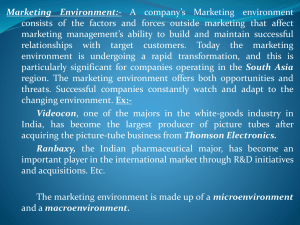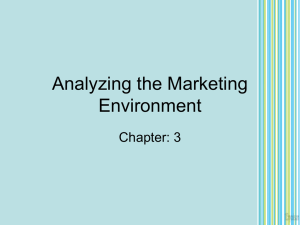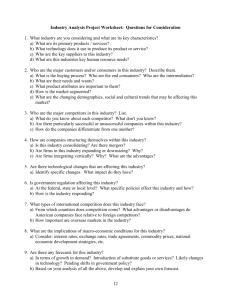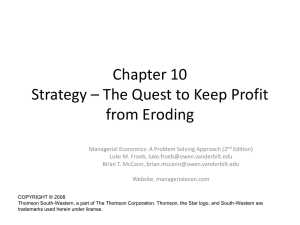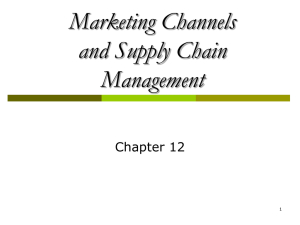marketing environment
advertisement
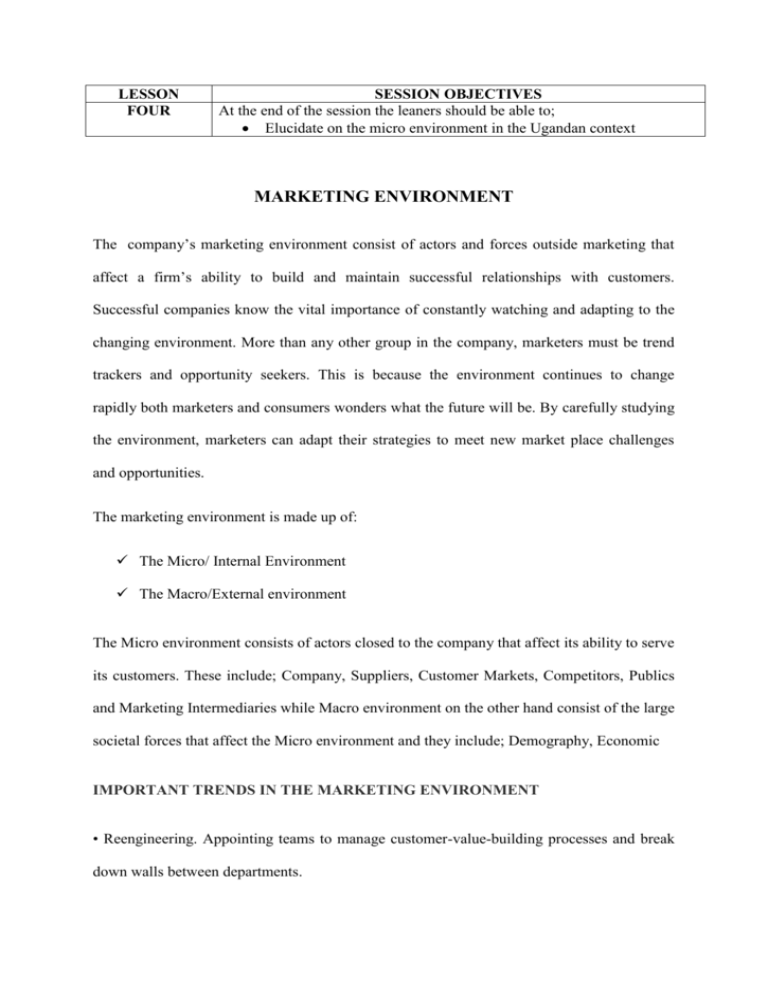
LESSON FOUR SESSION OBJECTIVES At the end of the session the leaners should be able to; Elucidate on the micro environment in the Ugandan context MARKETING ENVIRONMENT The company’s marketing environment consist of actors and forces outside marketing that affect a firm’s ability to build and maintain successful relationships with customers. Successful companies know the vital importance of constantly watching and adapting to the changing environment. More than any other group in the company, marketers must be trend trackers and opportunity seekers. This is because the environment continues to change rapidly both marketers and consumers wonders what the future will be. By carefully studying the environment, marketers can adapt their strategies to meet new market place challenges and opportunities. The marketing environment is made up of: The Micro/ Internal Environment The Macro/External environment The Micro environment consists of actors closed to the company that affect its ability to serve its customers. These include; Company, Suppliers, Customer Markets, Competitors, Publics and Marketing Intermediaries while Macro environment on the other hand consist of the large societal forces that affect the Micro environment and they include; Demography, Economic IMPORTANT TRENDS IN THE MARKETING ENVIRONMENTs in Marketing and T • Reengineering. Appointing teams to manage customer-value-building processes and break down walls between departments. • Outsourcing. Buying more goods and services from outside domestic or foreign vendors. • Benchmarking. Studying “best practice companies” to improve performance • Supplier partnering. Partnering with fewer but better value-adding suppliers • Customer partnering. Working more closely with customers to add value to their operations • Merging. Acquiring or merging with firms in the same or complementary industries to gain economies of scale and scope • Globalizing. Increasing efforts to “think global” and “act local” • Flattening. Reducing the number of organizational levels to get closer to the customer • Focusing. Determining the most profitable businesses and customers and focusing on them • Justifying. Becoming more accountable by measuring, analyzing, and documenting the effects of marketing actions • Accelerating. Designing the organization and setting up processes to respond more quickly to changes in the environment • Empowering. Encouraging and empowering personnel to produce more ideas and take more initiative • Broadening. Factoring the interests of customers, employees, shareholders, and other stakeholders into the activities of the enterprise • Monitoring. Tracking what is said online and elsewhere and studying customers, competitors, and others to improve business practices factors, Technological, Natural, Political and Cultural environment. THE MICRO ENVIRONMENT/ INTERNAL ENVIRONMENT Marketing departments’ main responsibility is to build relationships with customers by creating value and satisfaction. However, managers cannot do these alone; there are other actors in the company’s micro environment which include the following: Other departments, suppliers, marketing intermediaries, and customers. However, the company’s success will be affected by two additional groups namely, a set of competitors and a set of publics. Company management has to watch and plan for all these factors, competitors and various publics. Since, these departments combined to make up the companys’ value delivery system. 1. The Company In designing marketing plant, marketing management takes other companys’ group into account or consideration groups such as top management, finance, Research and Development (R&D), purchasing, operations and accounting. Top management sets the companys’ mission, objectives, strategies and polices. Marketing managers must also work with other companys’ departments. Finance is concern with findings and using funds to carry out the marketing plan. The R&D department focuses on designing safe and attractive products. Purchasing worries about getting supplies and materials where as operations is responsible for producing and distributing the desired quality and quantity of products. Accounting has to measure revenues and cost to help marketing how well it is achieving its objectives. Together, all these departments have an impact on the marketing departments’ plans and action. Under, the marketing concepts, all of these functions must “think consumer.” They should work in harmony to provide superior customer value satisfaction. 2. The Suppliers Suppliers are business firms who provide the needed resource to the company and its competitors to produce the particular goods and services. For example Bakery company must obtain sugar, wheat, cellophane paper and other materials to produce and package its breads. Labour, equipment, fuel/electricity and other factors of production are also to be obtained. In this case, the company must decide whether to purchase or make its own. When the company decides to buy some of the inputs, it must make certain specification call for tender etc. and then it segregates the list of suppliers. Usually companies choose the suppliers who offer the best mix of quality, delivery schedule credit, guarantee and low cost. They provide resources needed by the company to produce its goods and services. Suppliers’ problems can seriously affect marketing since they form an important link in the companys’ overall customer value delivering system. Therefore: Marketing managers must watch supply availability i.e. supply shortages/delays, labour strikes and other events that can cost sales in the short run and damage the customer’s satisfaction in the long run. Marketing managers should also monitor the price trend on their key input since rising supply cost may force price increase that can harm the companys’ sales volume. Managers should also treat their suppliers as partners so as to create and deliver customer value. Marketing managers should prefer to buy from multiple sources to avoid overdependence on any one supplier i.e. even for the appendage services to marketing like marketing research, advertising, sales training etc. the company use service from outside. This dependency may also create some bottlenecks, at times, due to the behaviour of these agencies and consequently affect the marketing operations of the company. 3. Marketing Intermediaries Marketing intermediaries are firms that help the company promote, sell and distribute its goods to final buyers. They include; resellers, physical distribution firm, marketing services agencies and financial intermediaries. Resellers: Are the distribution firms that help that help the company find customers/make sales of them. They include; wholesalers and retailers who buy and sell merchandise. Selecting and partnering with sellers is not easy. No longer do the manufactures have many small independent resellers from which to choose. They now face large and growing reseller’s organization which frequently have enough power to dictate terms or even shut the manufacturers out of large market. Physical distribution firms: These help the company to stock and move goods from their points of origin to their destination. Working with ware house and transportation firms, a company must determine the best ways to store and ship goods balancing factors such as; cost, delivery, speed and safety. Marketing services agencies: These are the marketing research firms, advertising agencies, media firms and marketing consulting firms that help the company target and promote its products to the right market. When the company decides to use one of these agencies, it must choose carefully because these firms vary in creativity, quality, service and price. Financial intermediaries: These include banks, credit companies, insurance companies and other businesses that help financed transactions against the risks associated with buying and selling of goods. Most firms and customers depend on financial intermediaries to finance their transactions. Like suppliers, marketing intermediaries form an important component of the companys’ value delivery system. In its quest to create the satisfying customers relationships, the company must do more than just optimized its own performance i.e. it must partner effectively with marketing intermediaries to optimize the performance of the entire system. 4. Customer Markets The marketers must study the customer markets very closely and adapt accordingly to changes affecting the customers. Failure to satisfy customers’ needs results in loss of such customers to the competitors. Customers needs and wants are constantly changing and its’ only through research and monitoring that organization can hope to understand its customers. Understanding customers helps an organization to develop products and services that satisfy customers. Therefore, customers are the fulcrum around whom the marketing activities of the organisation revolve. The marketer has to face the following types of customers: Customer Markets: Markets for personal consumption. Industrial Markets: Goods and services that could become the part of a product in those industry. Institutional Buyers: Institutions like schools, hospital, which buy in bulk. Reseller Markets: The organizations buy goods for reselling their products. Government Markets: They purchase the products to provide public services. International Markets: Consists of Foreign buyers and Governments. 5. Competitors The marketing concepts states that to be successful, the company must provide greater customer value and satisfaction than its competitors do. Thus, marketers must do more than simply adapting to the needs of target customers. They must also gain the strategic advantage by positioning their offering strongly against competitor’s offerings in the minds of consumers. For instance, if one company plans a marketing strategy at one side, there are number of other companies in the same industry doing such other calculations. Coke has competitors in Pepsi. Therefore, competition does not come ONLY from the branded segment but also from the generic market, that is; where there are only few branded products of rice but there are numerous generic variety of rice according to the local tastes in each region/country. Sometimes competition comes from different forms. Airlines have to overcome competitions not only from the other Airlines but also from Railways and Ships. Basically every company has to identify the competitor, monitor their activities and capture their moves and maintain customer loyalty. Hence every company comes out with their own marketing strategies. 6. Publics The company marketing environment also includes various public. A public is any group that has an actual or potential interest in or impact on an organizations’ ability to achieve its objectives. The following are the various types of public: Financial public: These influence the companys’ ability to obtain funds. Banks and stock holders are the major financial public i.e. they influence the public to get funds. Media public: These carries news, features and editorial opinion. They include news papers, magazines, radios and television stations. Government public: Here, management must take the government involvements in to account i.e. marketers must consult the company lawyers on issues of product safety, advertising among others. Citizens action public: A companys’ marketing decisions may be questioned/affected by consumer organizations, minority groups etc Local public: These include neighborhood residents and community organizations. Large companies usually appoint a community relation officers to deal with the community i.e. attend meetings, answer questions and contributes to worthwhile. General public: A company needs to be concerned about general attitudes to award its products and activities. The public image of the company affects its buying. Internal public: These include; workers, managers, volunteers and the board of directors. When employees feel good about their company; their positive attitudes spills over to the external public.
